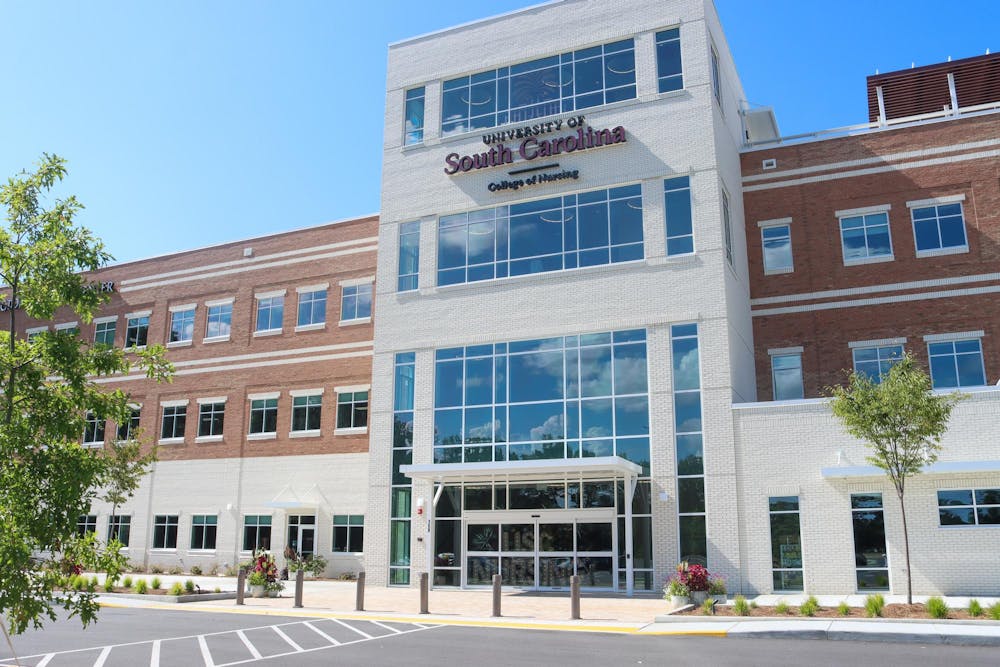Ten years ago, Jeanette Andrews, the dean of USC's College of Nursing, realized that the college would run out of space and began pitching an expansion to the nursing school’s Columbia building.
And on Aug. 12, Andrews saw her plan become a reality as she joined several other university officials to cut the ribbon to a major expansion to the school's nursing facilities.
The University of South Carolina and Lexington Medical Center opened their new satellite clinical education building during the ceremony. The new training facility will help the university enroll more students in its nursing program, university President Michael Amiridis said.
The 52,000-square-foot facility contains classrooms, study spaces and the Center for Simulation and Experiential Learning, which has four sections where students will replicate various clinical scenarios in a controlled environment. The new simulation lab is three times the size of the college's current lab and will open the previous space for graduate research.
The need for the project also stemmed from a nationwide nursing shortage, said Tod Augsburger, the CEO of Lexington Medical Center.
“Over the next 10 years, the nursing workforce will face dramatic changes, including the expected retirement of more than one million nurses nationally,” Augsburger said at the opening. “South Carolina itself is facing the ninth highest projected nursing shortage in the country.”
Through this partnership, Lexington Medical Center will provide USC with space and clinical instructors, while the university increases its faculty and the size of its nursing program, said Melissa Taylor, the vice president of patient care and chief nursing officer for Lexington Medical Center.
“It helps organizations like us, that are looking for nurses,” Taylor said. “We need to increase the total number of nurses that schools are graduating, and this partnership will allow us to do that.”
When the center encouraged the university to increase the enrollment of nursing students, Andrews said the program had limitations.
“I said, 'Sure, we have the students, we have a lot of interest in our program,’” Andrews said. “But we just didn’t have the classroom space or the simulation space.”
The West Columbia hospital then offered the land which the new building sits on, she said. After about six months of planning and a 14-month build, the project has been completed.
The building will allow the university to almost double the amount of undergraduates in the field, Amiridis said.
“Capacity is the problem,” Amiridis said. “Having the capacity in order to produce the high-quality students that we want, with the high-quality experience that they get. So that’s why facilities are important, and that gives us the ability to do it.”

Fourth-year nursing student Charlotte Burts said she is excited about the opportunities that the facility will give students and the increased space it will provide.
“Seeing the really large, new classrooms is really exciting,” Burts said. “I think it's gonna be a really good atmosphere to learn and be able to collaborate with other nursing students. The sim lab is also beautiful and amazing. I think it's a really good opportunity for students, especially up-and-coming, upper-division students to get a lot of good simulation experience.”
The College of Nursing has made other efforts in recent years to increase the amount of graduating nurses. Three years ago, the college started the Master's Entry to Practice Nursing, a five-semester program for students with bachelor's degrees in non-nursing fields, Andrews said.
“We’re also putting new nurses in the workforce, from people who (are) choosing nursing as a second career,” she said.
The college is also aiming to increase its graduate enrollment in order to produce more nursing faculty to train future students, Andrews said.
“There’s a shortage of nursing faculty around the country and in South Carolina,” Andrews said. “So having more nurses with doctorate degrees allows us to enroll more students.”
Figuring out how to keep nurses in the field is part of solving the shortage, Taylor said. This could include making hours more flexible and increasing the variety of jobs available.
“Perhaps they don’t want to work 12 hours on the floor anymore,” Taylor said. “But are there other positions that we can give them to keep them in that field longer?”
The two institutions commemorated the opening of the building with a ribbon cutting ceremony, with speeches from Augsburger, Amiridis, Andrews and South Carolina Sen. Nikki Setzler (D-District 26). The event was a significant moment for Setzler, he said.
"As a life-long, diehard Gamecock and a longtime advocate and supporter of Lexington health and the Lexington health system," Setzler said. "This is a special day for me to see these two institutions come together to do what they're doing here."
The university is open to partnerships with a variety of groups, Amiridis said. And Setzler said he believes that more partnerships between USC and the Lexington health system are in the future.
“We know this is the first — not the only, not the last — but the first in many new partnerships between these two institutions,” Setzler said.

